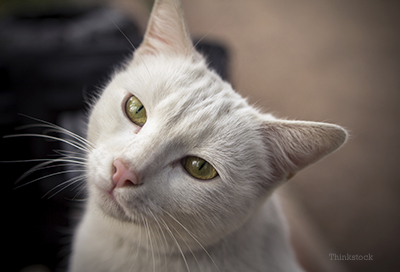
Kidney stones form in cats for a few different reasons. The different causes ultimately predict which type of nephro (kidney) + lith (stone) is most likely to form. And the type of stone affects what treatments might help. Cats with small kidney stones really may have no signs at all. Kidney stones may show up on x-rays of the belly that are being taken for unrelated reasons, as a so called “incidental” finding. Since kidney stones in cats don’t seem painful, why should we worry about them?
A kidney stone that allows normal urine flow out may be one that your vet watches closely, but ultimately leaves untreated. However, if the stone gets very large, or if little pieces break off and lodge in the ureter (the long narrow tube that connects each kidney to the urinary bladder), it likely becomes very painful. Kidney colic—signaled by abdominal pain, malaise and even vomiting—may result; the kidney may swell and be damaged. If this should happen simultaneously to each kidney, and the blockage persists, your kitty will likely become critically ill from the disrupted flow of urine. If you think your cat’s abdomen is painful, or his urinations change in any way, please contact your veterinarian right away. A urinary obstruction is a life threatening emergency that must be treated!
Signs of kidney stones in cats
The signs and symptoms of kidney stones could include:
- Fever
- Abdominal discomfort
- Kidney pain
- Blood in the urine (hematuria)
- Altered urine production (increased or decreased)
- Lethargy
- Poor appetite
- Vomiting
- Weight loss
Diagnosis of kidney stones in cats
Most stones usually show up readily on plain radiographs, but small stones may be hidden behind intestinal contents. Another reason that simple x-rays may not give enough information is because certain stones just don’t show up well. An example would be a urate stone, which might occur as a result of liver disease. Once a stone has been diagnosed, your vet will want to do some tests to help with predicting the stone type. Tests are needed also to assess what impact the stone(s) may be having on your cat’s kidney health, and whether other conditions may be present that might increase the risk of stones. Testing may include:
- Complete blood count (CBC)
- Blood chemistry with electrolytes — Testing for evidence of kidney disease and risk factors for stone formation
- Urinalysis— The urine quality may predict kidney disease and help identify bacterial infection or crystals that may help predict stone type
- Urine culture with susceptibility— To identify bacterial infection and the best antibiotic choice(s)
- Abdominal radiographs (x-rays)— To examine the size and shape of the kidneys and look for urinary stones
- Systemic blood pressure— To identify an important complication of kidney disease
- Abdominal ultrasound— This will help verify the location of any stones and the suspected degree of any obstruction
- Contrast radiography— Dye studies may be needed to confirm blockage and help to show the contribution that each kidney makes to urine production.
Causes and types of kidney stones in cats
Most cats affected by stones are middle aged or older1.
Metabolic kidney stones (those formed due to a blood or urinary imbalance) are much more common in cats than infection-based stones1. Your veterinarian will determine treatment based on the kind of stone and what it’s made of.
Treatment of kidney stones in cats
A reason to treat kidney stones is bacterial urinary infections that recur or cannot be cleared. Veterinarians often struggle to determine whether the stone or the infection comes first, but sometimes eliminating a kidney stone is needed to help resolve the infection.
Again, with some types of urinary stones, your veterinarian may want to treat conservatively, with a combination of antibiotics, diet and plenty of fluids. Dissolving kidney stones completely often takes months, but any early reduction in size is great news.
It’s likely that your kitty with a kidney stone will not need more specific treatment to remove it. But it’s good to be prepared, and to understand what’s involved if the situation changes. Medical efforts to dissolve feline kidney stones are usually safer than surgery, but won’t work for most stones. Since most feline kidney stones won’t dissolve, plans for treatment can be challenging for your cat’s veterinary team. Skilled surgery is widely available to remove kidney stones, but does risk permanently damaging the affected kidney, even if the surgery goes smoothly.
Special techniques to break up a stone (lithotripsy for example) are not usually recommended for cats because the stone fragments tend to lodge in their narrow ureters2. Fortunately, veterinary specialists are continuing to find better treatments of cat kidney stones by applying advanced techniques, commonly used in people, to our feline friends. For some cats, specialists may recommend treatment with an endoscope (a small device with a light attached). For emergency situations, when the ureters are blocked, they might recommend life- saving bypass techniques that re-route urine around the blocked ureters3. It’s always fair to ask your doctor if surgery is the only option, or if there might be a cutting edge technology to try, instead of surgical cutting.
Monitoring and management of kidney stones in cats
If your vet suspects oxalate kidney stones, she may suggest a special diet and some medications to reduce or slow stone growth, with a big emphasis on increasing kitty’s water intake. By encouraging your cat to drink more, or to take extra water in the form of canned food, the urine should be more dilute. The goal here is to reduce the amount of mineral available to add to a stone.
Many special diets are available to prevent or manage urinary stones, but finding the best fit for your cat could take some trial and error. Your vet will also want to balance the dietary needs of any other illness that kitty has, such as kidney disease, diabetes or gastrointestinal disease. If an underlying cause for stones is suspected, then resolving that primary problem will be a key part of any plan.
Even if the stones don’t seem to be causing complications now, your vet will likely ask you to agree to regular monitoring of blood and urine tests for the foreseeable future. It’s important to know that any prevention strategy is working, and to show that the stones are not growing or causing complications. Likely your vet will recommend repeating radiographs (x-rays) or ultrasound studies periodically. If the stones have been removed, monitoring for any recurrence will be critical to keeping your kitty healthy. You and your veterinarian can map out the monitoring schedule that best matches your cat’s condition.
If you have any questions or concerns, you should always visit or call your veterinarian -- they are your best resource to ensure the health and well-being of your pets.
Resources:
- Jessica E Markovich and Mary Anna Labato, Medical Management of Nephroliths and Ureteroliths in JD Bonagura and DC Twedt ed Kirk’s Current Veterinary Therapy XV, Saunders Elsevier, St. Louis, 2014 PP 892-896
- (3tate of the Art: Nephroliths and Ureteroliths - A New Stone Age World Small Animal Veterinary Association World Congress Proceedings, 2013 Larry G. Adams, DVM, PhD, DACVIM (SAIM) Purdue University, West Lafayette, IN, USA
- Proceedings: Diagnosis and Management of Feline Ureteral Obstructions: Past Present and Future ACVIM 2014 Allyson Berent DVM, DACIM (SAIM) New York NY

